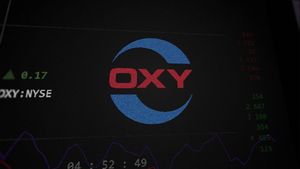
Liontown Resources Ltd (ASX: LTR) captured the attention of the Australian financial markets today, October 2, 2025, with its shares rocketing an impressive 9.66%. This significant surge positioned the Perth-based lithium developer as a leading gainer on the S&P/ASX 200 index. Curiously, the substantial price movement occurred in the absence of any fresh company-specific news or announcements, prompting investors and analysts alike to search for the underlying catalysts driving this sudden bullish sentiment.
The unexpected rally in Liontown's stock suggests a broader market recalibration within the critical minerals sector, particularly lithium. While individual company news often dictates such sharp movements, today's performance points towards a powerful confluence of macro-economic factors and shifting investor perceptions regarding the long-term demand for battery metals, overriding immediate supply concerns.
Unpacking the Lithium Leap: Broader Market Dynamics at Play
Today's robust performance by Liontown Resources (ASX: LTR), closing at 0.965 AUD, was not an isolated event but rather a reflection of a stronger day for the broader Australian market. The S&P/ASX 200 index itself advanced by 1.13%, reaching a new one-month high, largely propelled by gains across various sectors, including a notable 1.83% increase in Metals & Mining. This general uplift in resource-related equities provided a fertile ground for lithium players.
More specifically, the lithium sector experienced what some analysts are terming a "miraculous recovery" on October 2, 2025. This rebound followed a slump on the preceding day, October 1, 2025, which was triggered by news of Chinese regulators approving updated reserve reports from producers in Yichun. This development had initially fueled fears of a global oversupply, sending lithium stocks lower. However, despite China's lithium markets being closed for holidays today, investor sentiment swiftly pivoted, looking beyond the immediate supply jitters towards more foundational drivers.
A pivotal development that undoubtedly bolstered confidence in the lithium market was the confirmation of the US Department of Energy (DOE) taking a 5% equity stake in Lithium Americas (NYSE: LAC) and its Thacker Pass lithium project in Nevada. This unprecedented federal equity investment in a commercial lithium production facility unlocks substantial loan funding and paves the way for new third-party offtake agreements. This strategic move by the US government serves as a powerful "sector signal," underscoring the critical importance of securing domestic supply chains for energy transition minerals. This strong governmental commitment to lithium supply, even in North America, resonates globally, positively influencing investor perceptions for developers like Liontown Resources in Australia. The market appears to be balancing the "Critical Minerals Dilemma," weighing current oversupply realities against the undeniable projections of a fourfold increase in demand for key energy transition metals between 2025 and 2035, with spodumene prices anticipated to rise towards US$1155 by 2027.
Companies on the Cusp: Winners and Losers in the Lithium Landscape
The surge in Liontown Resources (ASX: LTR) shares today, catalyzed by broader market and sector-specific tailwinds, points to potential shifts in fortunes for various players across the lithium value chain. While Liontown itself is a clear beneficiary of this renewed investor confidence, the ripple effects are likely to be felt by other companies, both directly and indirectly involved in the critical minerals space.
Potential Winners:
- Other Australian Lithium Developers and Producers: The positive sentiment surrounding Liontown is highly likely to spill over to its peers on the ASX. Companies such as Pilbara Minerals (ASX: PLS), Allkem (ASX: AKE), and Mineral Resources (ASX: MIN), which are significant players in lithium mining and processing, could see increased investor interest. The US DOE's investment in Lithium Americas (NYSE: LAC) underscores the strategic value of securing non-Chinese lithium supply, benefiting Australian producers who are key to diversifying the global supply chain. This could lead to re-ratings or increased acquisition interest in these companies as global demand intensifies.
- Electric Vehicle (EV) Manufacturers with Offtake Agreements: While initially appearing to be on the "demand" side, EV manufacturers that have secured long-term offtake agreements with lithium producers at favorable terms could see their supply chain stability enhanced. Companies like Tesla (NASDAQ: TSLA), which has direct or indirect ties to various lithium projects, would benefit from a more robust and well-funded upstream lithium sector, ensuring consistent supply for their ambitious production targets.
- Battery Manufacturers: Similarly, battery cell manufacturers such as LG Energy Solution (KRX: 373220) and Panasonic (TYO: 6752) rely heavily on a stable and affordable supply of lithium. A healthier, more confident lithium mining sector, spurred by strategic investments and long-term demand projections, ultimately supports the expansion and innovation within the battery manufacturing industry.
Potential Losers (or those facing increased pressure):
- Companies reliant on a depressed lithium price: While the overall trend is positive, any company that has based its strategic planning on a prolonged period of low lithium prices might find their competitive edge eroding. This could include some niche battery technologies or chemical producers that might have anticipated cheaper feedstock.
- Producers with high operating costs or less attractive assets: In a market where investment is flowing into strategic, high-quality projects, companies with less economic deposits or higher operational expenditures might struggle to attract capital or compete effectively. While the rising tide lifts all boats, the most efficient and strategically important assets will likely benefit disproportionately.
- Chinese Lithium Producers (in the context of Western supply chain diversification): While China remains a dominant force, the US DOE's investment in North American lithium signals a clear intent by Western nations to reduce reliance on Chinese supply chains. This geopolitical shift, while not immediately detrimental, could put long-term pressure on Chinese producers' market share in non-Asian markets and potentially influence pricing dynamics as alternative supply routes mature.
The overall impact of today's market movements is likely to be a re-evaluation of lithium assets globally, with a renewed focus on strategic importance, supply chain security, and long-term demand fundamentals.
Wider Significance: A Glimpse into the Future of Critical Minerals
The unexpected surge in Liontown Resources (ASX: LTR) stock today, driven by broader market sentiment rather than company-specific news, carries significant implications for the wider critical minerals industry. This event is not merely a single stock's gain but a barometer of evolving trends, potential ripple effects, and the ongoing geopolitical dance surrounding the energy transition.
This event fits squarely into the broader industry trend of "resource nationalism" and the global race to secure critical mineral supply chains. The US DOE's equity stake in Lithium Americas (NYSE: LAC) is a potent example of governments actively intervening to de-risk and accelerate the development of strategic mineral projects. This signals a shift from purely market-driven investment to a more geopolitically influenced allocation of capital, particularly for minerals deemed essential for national security and economic future, like lithium. This trend suggests that companies with assets in politically stable jurisdictions, or those aligned with Western supply chain diversification efforts, might command a premium.
The potential ripple effects on competitors and partners are substantial. For Australian lithium miners, this renewed interest could lead to improved valuations, easier access to capital for project development, and potentially more favorable offtake agreements. It could also spur increased M&A activity as larger players or downstream partners look to secure future supply. Conversely, companies heavily reliant on traditional, less diversified supply routes might face increasing pressure to adapt their strategies. The event also underscores the growing importance of ESG (Environmental, Social, and Governance) factors, as Western governments and consumers increasingly demand ethically sourced and environmentally responsible critical minerals, potentially favoring projects with higher standards.
Regulatory and policy implications are also profound. The US DOE's move could inspire similar initiatives from other nations or blocs, such as the European Union, to bolster their own critical mineral strategies. This could manifest in further government grants, loan guarantees, or even direct equity investments in mining and processing projects. Such policies would accelerate the development of new mines and processing facilities, potentially easing future supply bottlenecks but also influencing market dynamics and pricing structures. The interplay between trade policies, environmental regulations, and critical mineral strategies is set to intensify.
Historically, periods of significant commodity price volatility, coupled with geopolitical tensions, have often led to strategic realignments in global supply chains. The current situation bears some resemblance to past efforts to secure oil supplies during energy crises, albeit with a focus on green energy. The "Critical Minerals Dilemma," balancing short-term oversupply with long-term demand, is a recurring theme in commodity markets, where investor sentiment often swings between immediate concerns and future potential. Today's move suggests a strong leaning towards the latter, indicating that the market is beginning to price in the long-term, structural demand for lithium, even amidst temporary gluts.
What Comes Next: Navigating the Evolving Lithium Landscape
The significant stock price appreciation of Liontown Resources (ASX: LTR) today, driven by broader market forces rather than company-specific news, signals a potentially pivotal moment for the lithium sector. Investors and industry participants must now consider both the short-term implications and the long-term strategic adjustments that may follow.
In the short-term, we could anticipate continued volatility but with an underlying bullish bias for quality lithium assets. The market will likely scrutinize upcoming quarterly reports from lithium producers for any signs of actual demand uptick or production guidance changes. Furthermore, any new policy announcements from major economies regarding critical minerals, especially from the US or EU, will be closely watched. This environment presents market opportunities for agile investors to capitalize on potential re-ratings of undervalued lithium developers, but also challenges in distinguishing between genuinely strategic assets and those merely riding the wave of sentiment. The absence of company-specific news for Liontown means that its next corporate update or project milestone will be even more impactful in validating today's gains.
For the long-term, the implications are more structural. We are likely to see continued strategic pivots by both mining companies and consuming industries. Mining companies may accelerate project development, explore new technologies for extraction and processing to enhance efficiency and reduce environmental footprint, and seek partnerships that offer supply chain security. Offtake agreements may become even more sophisticated, potentially involving equity stakes or long-term pricing mechanisms that share risk and reward. The potential scenarios and outcomes include a more diversified global lithium supply chain, with new production hubs emerging outside of traditional areas, particularly in North America and Europe, supported by government initiatives. This could lead to a more resilient, albeit potentially more complex, supply network for battery raw materials.
Ultimately, today's move for Liontown Resources underscores the market's growing conviction in the fundamental, long-term demand for lithium, driven by the inexorable global energy transition. While short-term supply-demand imbalances may create headwinds, the strategic importance of lithium is increasingly being reflected in market valuations and governmental policy.
Comprehensive Wrap-Up: Lithium's Enduring Significance
Today's remarkable 9.66% surge in Liontown Resources (ASX: LTR) stock, despite a lack of company-specific news, stands as a powerful testament to the underlying strength and strategic importance of the lithium sector. The event serves as a crucial summary of key takeaways: the market is increasingly prioritizing long-term demand fundamentals over short-term supply fluctuations, government intervention is becoming a significant de-risking and accelerating factor for critical mineral projects, and the global race to secure diversified supply chains is intensifying.
Assessment of the market moving forward suggests a period of heightened activity and re-evaluation within the critical minerals space. While the "Critical Minerals Dilemma" of balancing oversupply with future demand will persist, the decisive action by the US Department of Energy in supporting Lithium Americas (NYSE: LAC) has provided a strong positive "sector signal." This indicates a fundamental shift in how the market, and indeed governments, view the value and strategic necessity of lithium assets. This could lead to a more stable and ultimately higher valuation floor for well-positioned lithium developers and producers.
Final thoughts on significance and lasting impact point to a future where critical mineral supply chains are more localized, strategically de-risked, and deeply integrated with geopolitical objectives. The energy transition is not just an environmental imperative but a significant economic and national security one, and today's market movements reflect this profound understanding. The ripple effects will likely reshape investment flows, partnership structures, and regulatory landscapes across the entire battery value chain.
What investors should watch for in coming months includes further governmental policies and funding announcements related to critical minerals globally. Keep an eye on quarterly reports from major lithium producers for insights into production ramp-ups, cost efficiencies, and demand trends from downstream partners. Any new offtake agreements or strategic partnerships announced by companies like Liontown Resources (ASX: LTR) will be critical indicators of future growth and market confidence. Finally, monitor the broader economic indicators, particularly in key EV markets like China, Europe, and North America, as these will ultimately dictate the pace of demand for lithium and other battery metals.
This content is intended for informational purposes only and is not financial advice






